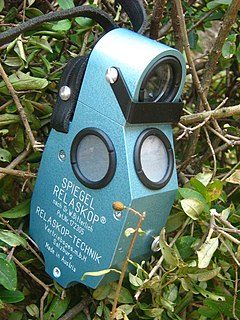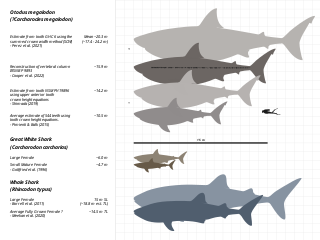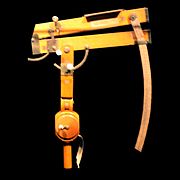Length is a measure of distance. In the International System of Quantities, length is a quantity with dimension distance. In most systems of measurement a base unit for length is chosen, from which all other units are derived. In the International System of Units (SI) system the base unit for length is the metre.

Measurement is the quantification of attributes of an object or event, which can be used to compare with other objects or events. The scope and application of measurement are dependent on the context and discipline. In natural sciences and engineering, measurements do not apply to nominal properties of objects or events, which is consistent with the guidelines of the International vocabulary of metrology published by the International Bureau of Weights and Measures. However, in other fields such as statistics as well as the social and behavioural sciences, measurements can have multiple levels, which would include nominal, ordinal, interval and ratio scales.

Lidar is a method for determining ranges by targeting an object with a laser and measuring the time for the reflected light to return to the receiver. Lidar can also be used to make digital 3-D representations of areas on the earth's surface and ocean bottom, due to differences in laser return times, and by varying laser wavelengths. It has terrestrial, airborne, and mobile applications.

Liriodendron is a genus of two species of characteristically large trees, deciduous over most of their populations, in the magnolia family (Magnoliaceae).

Diameter at breast height, or DBH, is a standard method of expressing the diameter of the trunk or bole of a standing tree. DBH is one of the most common dendrometric measurements.
The following outline is provided as an overview of and guide to forestry:

A diameter tape (D-tape) is a measuring tape used to estimate the diameter of a cylinder object, typically the stem of a tree or pipe. A diameter tape has either metric or imperial measurements reduced by the value of π. This means the tape measures the diameter of the object. It is assumed that the cylinder object is a perfect circle. The diameter tape provides an approximation of diameter; most commonly used in dendrometry.

Tree allometry establishes quantitative relations between some key characteristic dimensions of trees and other properties. To the extent these statistical relations, established on the basis of detailed measurements on a small sample of typical trees, hold for other individuals, they permit extrapolations and estimations of a host of dendrometric quantities on the basis of a single measurements.
Forest inventory is the systematic collection of data and forest information for assessment or analysis. An estimate of the value and possible uses of timber is an important part of the broader information required to sustain ecosystems. When taking forest inventory the following are important things to measure and note: species, diameter at breast height (DBH), height, site quality, age, and defects. From the data collected one can calculate the number of trees per acre, the basal area, the volume of trees in an area, and the value of the timber. Inventories can be done for other reasons than just calculating the value. A forest can be cruised to visually assess timber and determine potential fire hazards and the risk of fire. The results of this type of inventory can be used in preventive actions and also awareness. Wildlife surveys can be undertaken in conjunction with timber inventory to determine the number and type of wildlife within a forest. The aim of the statistical forest inventory is to provide comprehensive information about the state and dynamics of forests for strategic and management planning. Merely looking at the forest for assessment is called taxation.
Stand density index is a measure of the stocking of a stand of trees based on the number of trees per unit area and diameter at breast height (DBH) of the tree of average basal area, also known as the quadratic mean diameter. It may also be defined as the degree of crowding within stocked areas, using various growing space ratios based on crown length or diameter, tree height or diameter, and spacing. Stand density index is usually well correlated with stand volume and growth, and several variable-density yield tables have been created using it. Basal area, however, is usually satisfactory as a measure of stand density index and because it is easier to calculate it is usually preferred over SDI. Stand density index is also the basis for Stand density management diagrams.

The relascope, invented by Walter Bitterlich, is a multi-use instrument for forest inventory. It is primarily used to find the height of a tree, the basal area of a tree, and the diameter of a tree anywhere along the bole. This instrument is used mostly for applications involving variable radius sample plots in a forest survey.
Tree height is the vertical distance between the base of the tree and the tip of the highest branch on the tree, and is difficult to measure accurately. It is not the same as the length of the trunk. If a tree is leaning, the trunk length may be greater than the height of the tree. The base of the tree is where the projection of the pith (center) of the tree intersects the existing supporting surface upon which the tree is growing or where the seed sprouted. If the tree is growing on the side of a cliff, the base of the tree is at the point where the pith would intersect the cliff side. Roots extending down from that point would not add to the height of the tree. On a slope this base point is considered as halfway between the ground level at the upper and lower sides of the tree. Tree height can be measured in a number of ways with varying degrees of accuracy.
Tree girth measurement is one of the most ancient, quickest, and simplest of foresters' measures of size and records of growth of living and standing trees. The methods and equipment have been standardized differently in different countries. A popular use of this measurement is to compare outstanding individual trees from different locations or of different species.
In forestry, a tree crown measurement is one of the tree measurements taken at the crown of a tree, which consists of the mass of foliage and branches growing outward from the trunk of the tree. The average crown spread is the average horizontal width of the crown, taken from dripline to dripline as one moves around the crown. The dripline being the outer boundary to the area located directly under the outer circumference of the tree branches. When the tree canopy gets wet, any excess water is shed to the ground along this dripline. Some listings will also list the maximum crown spread which represents the greatest width from dripline to dripline across the crown. Other crown measurements that are commonly taken include limb length, crown volume, and foliage density. Canopy mapping surveys the position and size of all of the limbs down to a certain size in the crown of the tree and is commonly used when measuring the overall wood volume of a tree.
Tree volume is one of many parameters that are measured to document the size of individual trees. Tree volume measurements serve a variety of purposes, some economic, some scientific, and some for sporting competitions. Measurements may include just the volume of the trunk, or the volume of the trunk and the branches depending on the detail needed and the sophistication of the measurement methodology.
Trees have a wide variety of sizes and shapes and growth habits. Specimens may grow as individual trunks, multitrunk masses, coppices, clonal colonies, or even more exotic tree complexes. Most champion tree programs focus finding and measuring the largest single-trunk example of each species. There are three basic parameters commonly measured to characterize the size of a single trunk tree: height, girth, and crown spread. Additional details on the methodology of Tree height measurement, Tree girth measurement, Tree crown measurement, and Tree volume measurement are presented in the links herein. A detailed guideline to these basic measurements is provided in The Tree Measuring Guidelines of the Eastern Native Tree Society by Will Blozan.

Size in general is the magnitude or dimensions of a thing. More specifically, geometrical size can refer to linear dimensions, area, or volume. Size can also be measured in terms of mass, especially when assuming a density range.

A unit of volume is a unit of measurement for measuring volume or capacity, the extent of an object or space in three dimensions. Units of capacity may be used to specify the volume of fluids or bulk goods, for example water, rice, sugar, grain or flour.









